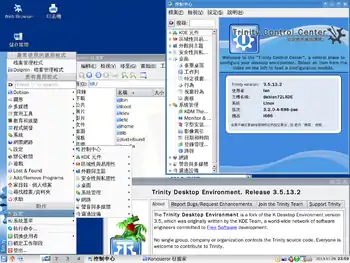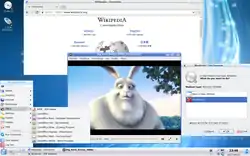Trinity Desktop Environment
The Trinity Desktop Environment (TDE) is a complete software desktop environment designed for Unix-like operating systems, intended for computer users preferring a traditional desktop model, and is free/libre software. Born as a fork of KDE 3.5 back in 2010, it was originally created by Timothy Pearson, who had coordinated Kubuntu remixes featuring KDE 3.5 after Kubuntu switched to KDE Plasma 4.[3]
 | |
_R14.0.5_Development.png.webp) Trinity R14.0.5 Development | |
| Developer(s) | TDE development team |
|---|---|
| Stable release | R14.0.9
/ 1 November 2020[1] |
| Preview release | 14.1.0 Development
/ 1 January 2020[2] |
| Written in | C++ (TQt) |
| Operating system | Unix-like with X11 |
| Platform | FreeBSD and Linux |
| Predecessor | K Desktop Environment 3 |
| Available in | Multilingual |
| Type | Desktop environment |
| License | GPL and other licenses |
| Website | trinitydesktop |



TDE is now a fully independent project with its own personality and development team, available for various Linux distros, BSD and DilOS. It is currently led by Slávek Banko.
TDE releases aims to provide a stable and highly customizable desktop, continuing bug fixes, additional features, and compatibility with recent hardware. Trinity is packaged for Debian, Ubuntu, Devuan, Raspbian, Fedora, RedHat, Mageia, OpenSUSE, Slackware and various other distributions and achitectures.[4] It is also used as the default desktop environment of at least two Linux distributions, Q4OS and Exe GNU/Linux.[5][6] Since version 3.5.12 (its second official release), it uses its own fork of Qt3, known as TQt3, so as to make it easier to eventually make TQt installable alongside later Qt releases.[7]
Releases
Early releases of Trinity used a versioning scheme based on that of K Desktop Environment 3.5, from which it was forked. The R14.0 release adopted a new versioning scheme, to prevent comparisons with KDE based on version number alone and a new visual theme.[8] This new visual theme was based on the "KDE Lineart" background included in the wallpapers package for KDE 3.4 and covered the desktop background and was named "Trinity Lineart" along with the splash screen, "application info screens" (for some apps like Konqueror and Trinity Control Center), and banners (for some other apps like KPersonalizer and Kate).[9] The window, widget, and icon themes were left intact, aside from replacing all KDE logos with Trinity logos.
Prior to this, Trinity kept the KDE 3.5 visual theme, but replaced the "KDE 3.5" branding with "TDE" branding, in a font that is not the "Kabel Book"[9] font KDE used, although the K-Menu had its side image branded as just "Trinity" instead of "TDE". Kubuntu versions, on the other hand, used the included "Crystal Fire" background as the default desktop background, along with the K-Menu "side image", larger menu items, and menu layout from Kubuntu 8.04.
History
| Date[10] | Event |
|---|---|
| 3.5 | |
| 29 April 2010 | 3.5.11 Maintenance release. |
| 3 October 2010 | 3.5.12 Maintenance release. |
| 1 November 2011 | 3.5.13 Maintenance release. |
| 12 October 2012 | 3.5.13.1 Maintenance release. |
| 21 July 2013[11] | 3.5.13.2 SRU release |
| 14.0 | |
| 16 December 2014[12] | 14.0.0 release |
| 30 August 2015[13] | 14.0.1 release |
| 28 November 2015[14] | 14.0.2 release |
| 28 February 2016[15] | 14.0.3 release |
| 7 November 2016[16] | 14.0.4 release |
| 18 August 2018[17] | 14.0.5 release |
| 30 March 2019[18] | 14.0.6 release |
| 30 December 2019[19] | 14.0.7 release |
| 29 April 2020[20] | 14.0.8 release |
| 1 November 2020[1] | 14.0.9 release |
References
- "Trinity Desktop Environment R14.0.9 Released!". trinitydesktop.org.
- "Nightly Builds". Trinity Desktop Project Wiki. Archived from the original on 2016-03-02. Retrieved 2016-02-29.
- Byfield, Bruce (29 June 2012). "Trinity KDE: KDE 3 Zombified or Resurrected?". Datamation. QuinStreet Inc. Archived from the original on 21 January 2012. Retrieved 3 November 2012.
- Trinity Desktop Project. "Trinity Desktop Environment". Retrieved 3 November 2012.
- Smith, J, ed. (26 August 2017). "DistroWatch: Exe GNU/Linux". DistroWatch. Copenhagen, Denmark: Unsigned Integer Limited. Retrieved 8 September 2017.
- Smith, J, ed. (26 August 2017). "DistroWatch: Q4OS". DistroWatch. Copenhagen, Denmark: Unsigned Integer Limited. Retrieved 8 September 2017.
- "Release Notes For 3.5.12 - Trinity Desktop Project Wiki". wiki.trinitydesktop.org. Retrieved 2017-08-26.
- "Trinity Desktop Environment R14.0.0 Released!". trinitydesktop.org. Retrieved 2017-08-17.
- "KDE - Clipart". www.kde.org. Retrieved 2017-08-17.
- "Trinity News". trinitydesktop.org. Retrieved 25 June 2017.
- Pearson, Timothy (21 July 2013). "Trinity Desktop Environment 3.5.13.2 SRU Released!". trinity-announce (Mailing list). Archived from the original on 2013-08-02.
- "Trinity Desktop Environment R14.0.0 Released!". Trinity News. 2014-12-16. Archived from the original on 2016-03-04. Retrieved 2016-02-29.
- "Trinity Desktop Environment R14.0.1 Released!". trinitydesktop.org. Retrieved 25 June 2017.
- "Trinity Desktop Environment R14.0.2 Released!". trinitydesktop.org. Retrieved 25 June 2017.
- "Trinity Desktop Environment R14.0.3 Released!". trinitydesktop.org. Retrieved 25 June 2017.
- "Trinity Desktop Environment R14.0.4 Released!". trinitydesktop.org. Retrieved 25 June 2017.
- "Trinity Desktop Environment R14.0.5 Released!". trinitydesktop.org. Retrieved 18 August 2018.
- "Trinity Desktop Environment R14.0.6 Released!". trinitydesktop.org. Retrieved 2 April 2019.
- "Trinity Desktop Environment R14.0.7 Released!". trinitydesktop.org.
- "Trinity Desktop Environment R14.0.8 Released!". trinitydesktop.org.
